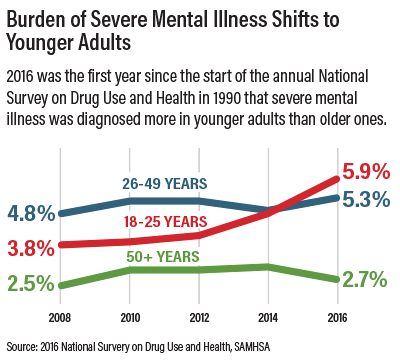SAMHSA Provides Latest Snapshot of Nation’s Drug Use, Mental Health
Abstract
While the 2016 National Survey on Drug Use and Health shows that opioid misuse did not increase in 2016, deaths from drug overdose continue to climb. The survey also found the percentage of younger adults with severe mental illness was greater than older adults in 2016.
Even as the nation shows signs of progress in the fight against opioids, data released last month by the Substance Abuse and Mental Health Services Administration (SAMHSA) points to a continued rise in deaths from opioid misuse.

This trend was one of several identified in SAMHSA’s latest National Survey on Drug Use and Health (NSDUH).
Based on the 2016 NSDUH, SAMHSA estimates 12.4 million people (4.3 percent of the population) misused prescription opioids in the past year, down from 11.8 million in 2015. An estimated 950,000 people used heroin in 2016, similar to reports of such use in 2015.
“The survey did not show opioid misuse and addiction becoming more common in 2016,” Health and Human Services Secretary Tom Price, M.D., said during a press conference announcing the latest findings from the 2016 NSDUH. “[T]he fact that we are not seeing this scourge spread any further than it has is a real testament to the work of communities across this country.
“But behind this seemingly stable picture, the situation is worsening, thanks to rising intensity and frequency of misuse and the emergence of illicitly made fentanyl and fentanyl analogs,” he continued. “We saw more than 50,000 drug overdose deaths, most of them due to opioids, in 2015—roughly equivalent to the number of Americans lost in the Vietnam War.” Preliminary data from the CDC suggest that the total number of deaths from drug overdose likely topped 60,000 in 2016, Price said.
Heroin, Cocaine Use Rise
While the overall use of heroin has doubled since 2002, CDC data have shown that heroin-related deaths have increased over 600 percent to an average of 13,000 deaths per year, Elinore McCance-Katz, M.D., Ph.D., assistant secretary for mental health and substance use, said at the press conference. McCance-Katz also suggested that the increase in heroin laced with rapid-acting fentanyl might be to blame for the rise in deaths from heroin.
Heroin is not the only street drug causing a significant health crisis, noted Richard Baum, acting director of the Office of National Drug Control and Policy. Cocaine use has risen to historically high levels, with the number of people in 2016 who reported using it in the past year (1.9 million) being the highest since 2008; the number of people who tried it for the first time (1.1 million) is the highest since 2002. Baum suggested that an increasing supply of cocaine coming into the United States may be to blame for the uptick in use. According to Baum, Colombia’s cocaine production has tripled over the past decade.
“Even as we focus our attention on opioids, we need to start thinking about heading off this next potential epidemic,” Baum said.
Young Adults Have Highest Prevalence Of Severe Mental Illness
For the first time since the NSDUH’s debut in 1990, severe mental illness (SMI) has become more common among young adults (aged 18 to 25) than older adults. In 2016, 5.9 percent of adults aged 18 to 25 had an SMI compared with 5.3 percent of adults aged 26 to 49 and 2.7 percent of adults aged 50 and up.
What’s more, only half of the young adults surveyed reported receiving treatment for their mental illness, said McCance-Katz. Without treatment, youth with SMI may be more likely to use illicit substances and report suicidal thoughts and actions, she noted. Between 2008 and 2016, the annual percentage of adults 18 to 25 who had serious thoughts of suicide rose from 6.8 to 8.8 percent.
“[This] report underscores the serious challenges we face with the opioid crisis and serious mental illness,” Price said. “The good news is that it is within our power to turn these trends around.”
Developing new strategies to address serious mental illness means embracing the concept of recovery in addition to prevention and intervention, said Paolo del Vecchio, M.S.W., director of SAMHSA’s Center for Mental Health Services. That includes programs that help with education, employment, or housing as part of a treatment regimen. The press conference was chosen for early September in part to promote National Recovery Month, which celebrates individuals across the country who have achieved long-term recovery from mental illness and substance use disorders.
The press conference included testimonials from three former patients: Emmanuel Ford and his mother, Esther Ford, and Zachary Talbott. The Fords discussed their journey in overcoming multigenerational depression, neglect, and posttraumatic stress disorder to form a strong family bond. Emmanuel explained how his recovery experience encouraged him to become a certified mental health peer specialist who works with youth in the Washington, D.C., area. Talbott described his experience overcoming opioid addiction—beginning first with addressing his denial that he was an addict—to complete his social work master’s degree and start his own opioid treatment program.
Daryl Kade, director of SAMHSA’s Center for Behavioral Health and Statistics and Quality, which oversees the NSUDH, mentioned that as part of a greater emphasis on recovery, the NSDUH has received permission to include recovery questions in next year’s survey, and she is looking forward to reviewing that national data in 2018. ■
The 2016 National Survey on Drug Use and Health can be accessed here.



